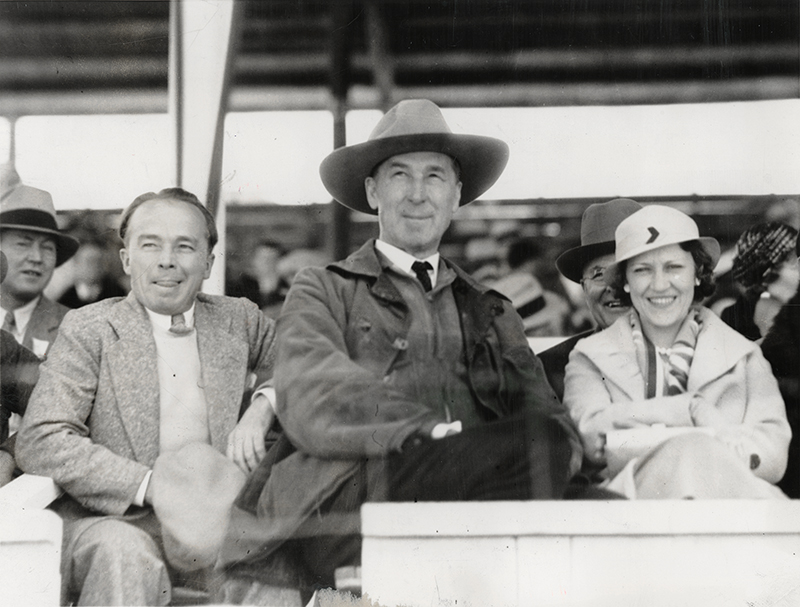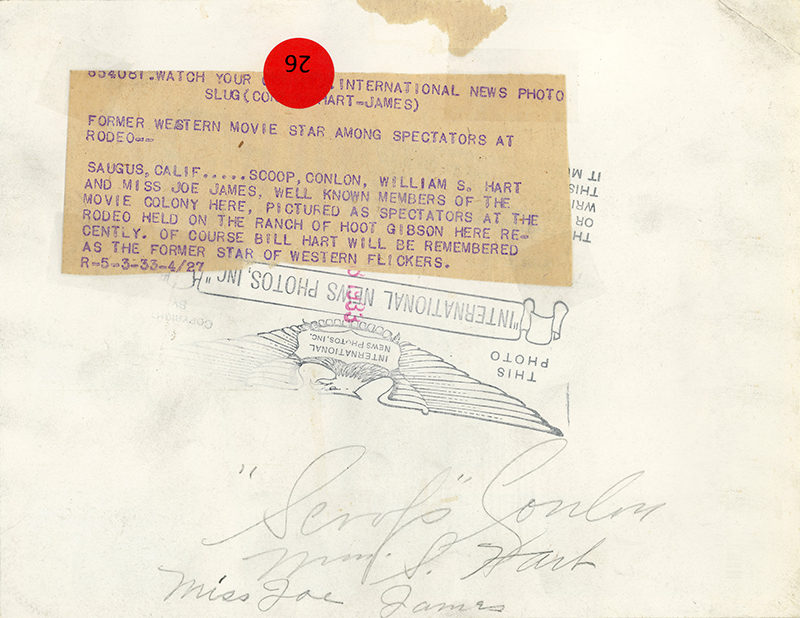|
|


Click image to enlarge
Sunday, April 30, 1933 — Western screen star William S. Hart didn't have to travel far from his Newhall home to watch the Hoot Gibson Rodeo on the south bank of the Santa Clara River, which would become the Saugus Speedway one day. At left is Hart's publicist, Paul H. "Scoop" Conlon, who took on Hart as a client in 1918 and stayed with him throughout (and obviously after) his film career (Davis 2003:124). At right is Miss Joe James. Don't know who she is. The 1933 rodeo was a qualifier, of sorts, for the 1933 Chicago World's Fair, inasmuch as the arena director for the Century of Progress Exhibition, "Skeeter Bill" Robbins, attended the rodeo to scout the best performers (Bakersfield Californian, April 21, 1933). Interntional News wire photo, 6x8 inches. Cutline (below) reads:
Former Western Movie Star Among Spectators at Rodeo —
Saugus, Calif. ... Scoop Conlon, William S. Hart and Miss Joe James, well known members of the movie colony here, pictured as spectators at the rodeo held on the ranch of Hoot Gibson here recently. Of course Bill Hart will be remembered as the former star of Western flickers. R-5-3-33-4/27 Although his film career ended with a whimper in 1925, Hart probably wouldn't have appreciated being called a "former" star. The local "film colony" would have included Hart and Gibson as well as actors Harry Carey of Saugus and Hart's neighbor Charley Mack, along with a passel of luminaries who were regular vistors, such as Wallace and Noah Beery.
About the Hoot Gibson Rodeo / Saugus Speedway.
About Saugus Speedway. The future Saugus Speedway was built originally as a rodeo arena in 1927 by Roy Baker, brother of shoe magnate C.H. Baker. Roy Baker purchased the 40-acre property east of Bouquet Junction in 1923 for the purpose of breeding and selling show and pleasure horses. To that end he imported saddle brood mares from Kentucky and studded them with a pedigreed, chestnut-colored saddlebred stallion named Peavine McDonald (b. 1910), which sired five pedigreed mares and four pedigreed colts between 1920 and 1936. Baker advertised that he had 2,500 acres of grazing land and also offered training and boarding services for outside horses. Probably to attract horse buyers to his ranch in faraway Saugus, Baker staged rodeos. Some references suggest he built a 12,000-seat arena in 1924, but this is dubious. (Promoter Bob Anderson organized a local rodeo in 1924, but its exact location is unclear, and it wouldn't have had grandtands.) Anderson did hold the annual rodeo on Baker's property in April 1926. That December, Baker and Anderson started construction on a new stadium, complete with partially covered grandstand seating and a quarter-mile oval track. When it opened May 1, 1927, it seated 18,000 fans, and thousands more had to be turned away for lack of room. Over the next decade, ownership of the arena would change hands three more times. As with a majority of the American populace, Baker was hit hard financially by the Great Depression of 1929 and was forced to sell the stadium to cowboy actor Hoot Gibson in 1930. Gibson continued to hold rodeos at the stadium and drew a Hollywood crowd including famous actors such as William S. Hart, Harry Carey, Tom Mix, and John Wayne. He also used the stadium as a movie set or leased it to other companies for film making. But Gibson felt the effects of the Depression, as well. In September 1933 he appeared in a Los Angeles courtroom and pleaded poverty, saying he had no assets with which to repay a $2,500 loan. He testified that he owned a one-third interest in Hoot Gibson Inc., which owned the Saugus rodeo, and that it was in arrears. In 1934, Gibson sold the stadium to Paul Hill, owner of the Western Livestock Stockyards, who continued to call it the Hoot Gibson Rodeo. As with his predecessors, however, the stadium brought Hill financial hardship when it was hit by the Great Flood of March 2, 1938. Heavy rains that year caused a river of water to flow down Soledad Canyon and filled the ranch home and arena with mud and debris. As reported in the Los Angeles Times, the "old buildings ... collapsed during the March floods" and the arena was built anew. Nonetheless, Hill lost the ranch sometime after the April 1938 rodeo. According to Reynolds, the property was repossessed by the bank. In 1939, ownership passed to William Bonelli, and it was renamed Bonelli Stadium. Bonelli, a professor of economics at Occidental College, continued the annual rodeo tradition for a number of years but introduced auto racing in 1939 on a more frequent schedule; ultimately auto racing became the primary draw and Bonelli renamed the arena Saugus Speedway. Occasional rodeos and circuses continued until at least the late 1960s, auto racing until 1995. The facility was sometimes used for concerts before the grandstands were removed in 2012 (the originals had been replaced in 1955). The venue continues to host an outdoor swap meet.
LW3240: 9600 dpi jpeg from original photograph purchased 2018 by Leon Worden.
|
The site owner makes no assertions as to ownership of any original copyrights to digitized images. However, these images are intended for Personal or Research use only. Any other kind of use, including but not limited to commercial or scholarly publication in any medium or format, public exhibition, or use online or in a web site, may be subject to additional restrictions including but not limited to the copyrights held by parties other than the site owner. USERS ARE SOLELY RESPONSIBLE for determining the existence of such rights and for obtaining any permissions and/or paying associated fees necessary for the proposed use.



